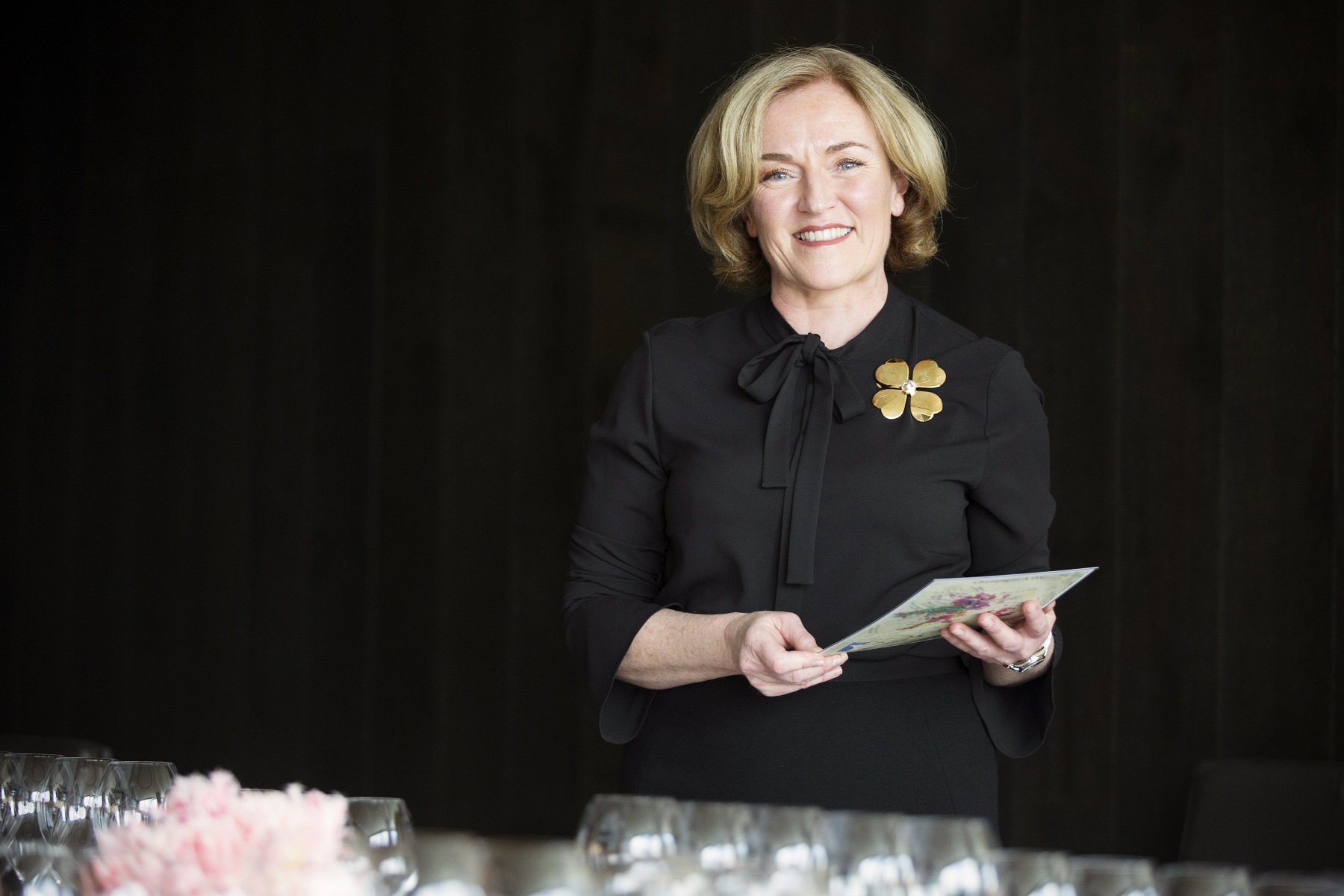There is a beautiful French quote: ‘Le champagne doit être au vin ce que la haute couture est à la mode‘, translated: ‘Champagne has to be to wine what haute couture is to fashion‘.
When it comes to champagne, the experience is one for the senses, but when it comes to a champagne experience with a true professional, you can be transported right to the region itself, without having to get on a plane.
That is exactly what you get when you meet the beautiful Sally Hillman, owner of Sally Hillman – Celebrating Champagne. From hosting luncheons to tastings, Sally’s love affair with champagne is long-standing and her passion to share her knowledge with others makes her experiences truly unforgettable.
I had the absolute delight of meeting Sally and sharing a beautiful bottle of champagne while discussing everything from her love of champagne to turning her passion into a beautiful, luxurious business.
Where did your love of champagne start?
My love of champagne started from a young age founded on traditional family celebrations.
My grandfather worked in the rural stockyards around Kyneton, Victoria, and was known for only ever drinking lemonade when he joined the boys for after-work drinks at the pub. Teetotaller Pa, however, always made an exception for champagne at family celebrations, because he said that partaking in champagne wasn’t really drinking! Champagne was for joyous times and it always lifted his spirits – and it became my drink of choice for the same reasons.
Combine this early indoctrination with the fact that I share my birthday with Saint Vincent, the patron saint of winegrowers, whose feast day is taken very seriously in Champagne, and it is easy to see that champagne was always going to feature in my destiny.
However it was a fortuitous introduction to a “grower-producer” champagne, a gift from a dear friend, many years ago that opened a new world for me and my fascination for these grower wines has blossomed ever since.
What inspired you to start the business?
My love of food, wine, and entertaining!
The French call it ‘l’art de recevoir’, which translates as ‘the art of receiving’ where no detail is left unturned; a seasonally based menu, fresh, seasonal flowers on the table, the perfect French glassware, candles, cutlery, crockery – a well-set table always sets the scene for an elegant, memorable experience.
Grower champagne is perhaps France’s best-kept secret and are the champagnes which the French drink every day.
I wanted to share my passion for grower champagne through an elegant champagne and food pairing experience.
You host some incredible culinary champagne experiences, what can guests expect when they attend and what do you hope they come away with?
My guests can expect to discover and explore a diverse selection of grower champagnes while enjoying a beautifully paired, seasonally inspired menu.
An elegantly set table is the cornerstone of our intimate, sophisticated experiences, providing the opportunity to socialise with friends and family or engage with corporate clients. Not only do we pair champagne throughout the meal, but we also match each Lehmann glass carefully to fully amplify the irrésistible magic and sophistication of champagne.
What do you hope they come away with?
Memories that will last a lifetime, in addition to the realisation that grower champagne is a wine that should be treasured and celebrated and as such can accompany an entire meal.
For wine enthusiasts, it is an opportunity to discover the lesser-known grower Houses of Champagne and to deepen their knowledge of this fascinating French wine. For novices, there is an opportunity to learn more about the depth, character, and quality that champagne has to offer.
What do you love most about hosting Champagne experiences?
Sharing knowledge of Champagne, its history, champagne wine styles, and etiquette, as well as shining a light on the passionate and innovative vignerons who continue to uphold the traditions and values of a truly special place in the world.
Seeing the acknowledgment, upon tasting, of how great grower champagnes are.
Providing the perfect environment for corporate clients to engage with valued clients as well as rewarding high performing team members, via a fine dining experience, exquisite champagne, and a lively atmosphere
You also have a beautiful line of glassware! What makes the range so special and how important is the right glass when enjoying champagne and wine?
At Sally Hillman, we believe the key to unlocking the magical secrets of terroir—whether it be in champagne, still wine, sake, or fine spirits—lies in the important selection of glassware that best reveals its message. We only use and recommend Lehmann crystal glassware designed in Reims, France.
Working in collaboration with the greatest professionals in the world of gastronomy, wine, and spirits, Lehmann Glass have been imagining and crafting unique tasting glasses ever since their inception. They have become synonymous with oenological excellence and are globally recognised as ‘The Wine Lover’s Label’.
Created by Gérard Lehmann, renowned glass designer, and Gérard Basset, sommelier extraordinaire, the French glassware brand unites expertise, passion, and innovation for a transformative wine tasting experience that stimulates a symphony of the senses.
Glassware is, after all, integral to each element of the tasting experience, with the ability to engage and enhance all five human senses: capturing the exciting, rhythmic sounds of the first pour; illuminating colourful hues and, in the case of champagne, joyful effervescence; providing clean curves to caress in hand, and distribute weight when swirling; to, finally, guiding the long-awaited rendezvous of smell and taste as aromas rise and flavours dance together.
Remarkably, 80% of flavour perception is derived from our sense of smell, so it is vital that glassware allows for the full and natural release of each and every aroma—from floral, fruit, and spice, to lees, oak, and more—for limitless enchantment and enjoyment.
After careful research and exploration, we unanimously agree that Lehmann crystal glassware offers the quintessential finishing touch to any table setting and tasting experience.
Describe champagne in 3 words
Uplifting, sophisticated, magical
If you could host a champagne dinner with 3 historical champagne figures, who would they be and why?
My choice of these three below would make for a very lively and intelligent discussion as they have all contributed significantly to champagne and Champagne!
Veuve Clicquot: In 1798 a young woman named Barbe-Nicole Ponsardin married François Clicquot, son of the founder of the Maison Clicquot. François shared his passion and knowledge for champagne creation and distribution with his young wife.
When François died unexpectedly Barbe-Nicole, aged only 27, became the Widow or “Veuve” Clicquot. She was a woman ahead of her time and with tenacity and brilliant business instincts, changed her pre-destined path when she took over the estate.
Barbe-Nicole didn’t just turn Clicquot’s ailing business into a thriving empire, she also revolutionised the champagne production process through her willingness to experiment and innovate.
She created the first recorded vintage champagne in Reims in 1810 and a few years later created the first “champagne rosé d’assemblage” made by blending red wine with champagne, instead of the traditional method of just adding an elderberry liqueur for colouring.
In 1816 she came up with her most revolutionary and lasting invention: the riddling rack. This is a table that holds the bottles on an angle, forcing the sediment formed during wine ageing into the bottles’ necks, to streamline the disgorging process and save time. This ingenious device took champagne making to a new level by guaranteeing a crystal-clear wine. It was quickly adopted by other wine-makers and the process is still used today, albeit in a recently mechanized form.
Madame Pommery: Another forward-thinking champagne producer who had greatness thrust upon her was Jeanne Alexandrine Louise Mélin who married Alexandre Pommery in 1839. Her husband ran the family champagne estate while Jeanne took a traditional background role, caring for him and their son. As she approached 40, life took a dramatic turn. In the space of 12 months, she gave birth to her daughter Louise and became a widow.
Like Madame Clicquot before her, Madame Pommery faced her destiny head-on. She threw herself into developing the Pommery brand and expanding the business. She purchased 120 crayères (limestone and chalk pits) carved underneath the city of Reims by Roman soldiers during their occupation of Gaul. These became the famous caves – unique cellars that allowed her to store and age thousands of bottles in a temperature-controlled environment. Many other Champagne houses would later follow suit.
Counterbalancing her focus on building a luxury brand was her commitment to philanthropy and corporate responsibility. She set up the first pension fund and social security for her workforce; funded the Reims orphanage and nursery; supported artists and bequeathed artifacts and art to the Reims Museum and the French state.
Apart from her generosity to the community, Madame Pommery delivered another gift for which we are truly grateful – the first brut in the history of champagne, the Pommery Nature 1874. This was a radical move as the prevailing taste was for very sweet champagne (up to 300gms of sugar per litre, compared with now up to 12 gms per litre).
Jeanne was succeeded by her daughter Louise as head of Pommery creating a solid lineage of female leadership.

Dom Pierre Pérignon, a 17th-century Benedictine monk who devoted his life to improving winemaking, served as cellar master to the Abbey of Hautvillers near Épernay.
Contrary to popular opinion, he didn’t invent sparkling wine, nor was he the first to make champagne. Quite the opposite! He worked hard to prevent secondary fermentation in the bottle which was seen as a fault and very likely to break the wine bottles.
This is a pity, because the story that he accidentally invented champagne and then yelled “Come quickly, I am drinking the stars,” has a nice ring to it.
Apparently, this quote first appeared in a print ad in the 1800s, long after the good Dom’s death.
While there is much debate about this story, there is no dispute about the enormous contribution Dom Pérignon made to champagne. He can be credited for developing the technique that finally produced a successful white wine from red wine grapes, something vintners had been trying to accomplish for years.
A major step toward the development of champagne.
He also established many of the fundamental practices of vineyard management that remain in use today:
- Using only the best grapes and discarding those that are damaged
- Pruning vines in the spring to avoid overproduction
- Picking in the cool temperatures of the morning and;
- Keeping the juices from each pressing separate.
Regardless of the embellishments, we owe a lot to Dom Perignon.













